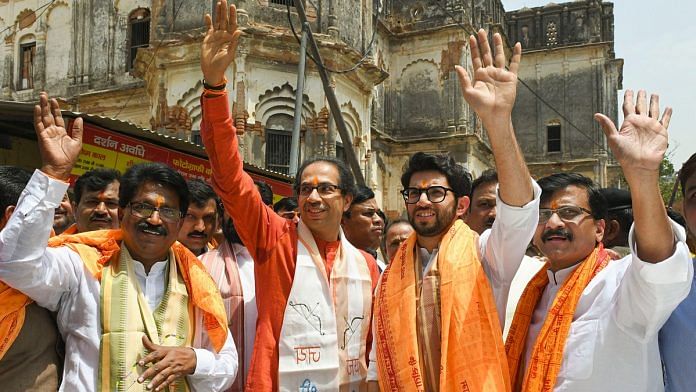New Delhi: Maharashtra Governor Bhagat Singh Koshiyari’s decision to not extend the deadline given to the Shiv Sena and Nationalist Congress Party to prove their ability to form government has triggered a controversy, with the Shiv Sena alleging that he was working “at the behest of the BJP”.
The Shiv Sena also moved the Supreme Court Tuesday, challenging the governor’s decision, and sought an urgent hearing of its petition.
This is, however, not the first time that the role of a governor has come under attack over accusations of bias. ThePrint takes a look at some of the decisions taken by governors of other states that ended up in the Supreme Court and the court’s decisions in those cases.
The 1994 S.R. Bommai case
The Shiv Sena’s petition cites the landmark verdict given in the 1994 S.R. Bommai v/s Union of India case to support its argument.
S.R. Bommai was the chief minister of Karnataka. In the judgment, the Supreme Court had set aside then Karnataka Governor P. Venkatasubbaiah’s decision to deny Bommai the chance to prove his majority on the floor of the House.
Bommai’s government was dismissed in April 1989, following which President’s Rule was imposed under Article 356. The dismissal was on the ground that Bommai had lost majority after large-scale defections engineered by several party leaders.
The Supreme Court, however, concluded that the President’s power to dismiss a state government is not absolute and that the dissolution of the legislative assembly should happen only where it is necessary.
“All cannons of propriety were thrown to the wind and the undue haste made by the governor clearly smacked of mala fides,” the court had said.
The Supreme Court also laid down guidelines for exercise of powers under Article 356. It, however, did not provide relief to the political parties as fresh elections were held by the time the court settled the case almost five years later.
The case has since become one of the most-cited in court petitions whenever a situation of a hung assembly has come up.
Governor’s discretion in Goa upheld
In the 2017 state elections in Goa, the BJP had won 13 of the 40 seats, while the Congress got 17. However, Governor Mridula Sinha invited late BJP leader Manohar Parrikar to form the government, prompting Goa Congress Legislature Party leader Chandrakant Kavlekar to approach the Supreme Court.
The court, however, sided with Sinha, observing that the “instant sensitive and contentious issue…can be resolved by a simple direction, requiring the holding of a floor test at the earliest”.
In doing so, a bench comprising then Chief Justice J.S. Khehar and Justices Ranjan Gogoi and R.K. Agarwal rejected senior advocate Abhishek Singhvi’s argument that in the absence of a pre-poll alliance, Sinha should have first spoken to the leader of the single-largest party.
“The holding of the floor test would remove all possible ambiguities, and would result in giving the democratic process, the required credibility,” the court had ruled.
Also read: Shiv Sena moves Supreme Court against Maharashtra Governor as govt formation talks continue
Stay away from ‘political horse-trading’
Unlike Goa, the governor’s decision in Arunachal Pradesh met with a different fate.
In July 2016, the Supreme Court quashed Arunachal Governor Jyoti Prasad Rajkhowa’s decision to advance the assembly session from 14 January 2016 to 16 December 2015, a move that triggered political unrest in the sensitive border state and led to the declaration of President’s Rule on 26 January 2016.
Rajkhowa’s actions had helped install a government of 14 rebel Congress MLAs, who had the outside support of the BJP and a couple of Independent MLAs. These Congress MLAs, who had rebelled against former CM Nabam Tuki and his government, had been disqualified by the Speaker.
Led by late Congress leader Kalikho Pul, the rebels approached Rajkhowa, demanding the Speaker’s impeachment. Rajkhowa then, acting without the advice of the Council of Ministers, advanced the assembly session to decide on the Speaker’s impeachment. The assembly session, which was held, selected Pul as the chief minister, prompting the Congress to move the Supreme Court.
Allowing the plea, a five-judge constitution bench comprising Justices Khehar, Dipak Misra, M.B. Lokur, P.C. Ghose and N.V. Ramana had directed that status quo ante (the previously existing state of affairs) as on 15 December 2015 be imposed immediately. The judgment was a stinging verdict on the role of the governor, with the court asserting that governors should steer clear of “political horse-trading”.
Congress govt in Uttarakhand restored
Around the same time, the Uttarakhand High Court had handed a major political setback to the BJP-led NDA government at the Centre, striking down President’s Rule in the state and ordering a fresh floor test.
In March 2016, Governor K.K. Paul had recommended the dismissal of the Harish Rawat government after a rebellion by nine Congress MLAs, led by former chief minister Vijay Bahuguna. Then-President Pranab Mukherjee had promptly obliged. Rawat then moved the high court.
Quashing the President’s Rule, then high court Chief Justice K.M. Joseph (who is now a Supreme Court judge) had said that the court was “pained” by the central government’s actions in the case and that it was acting like a “private party”.
The case reached the Supreme Court, which also ruled that the status of an elected government should be decided on the floor of the House. The Rawat government later went on to prove its majority and was reinstated.
Also read: How Uddhav Thackeray shed his Rahul Gandhi image to be a Shiv Sena leader in his own right



